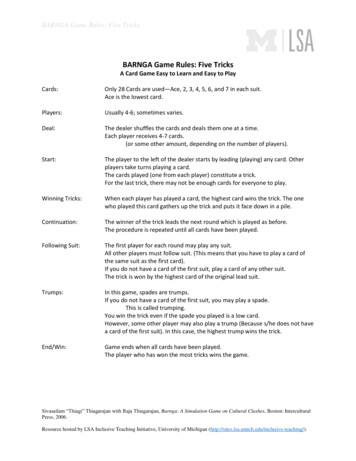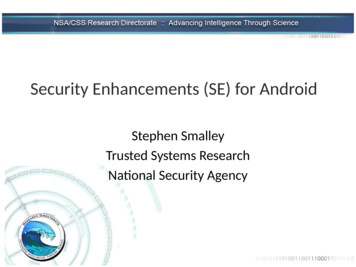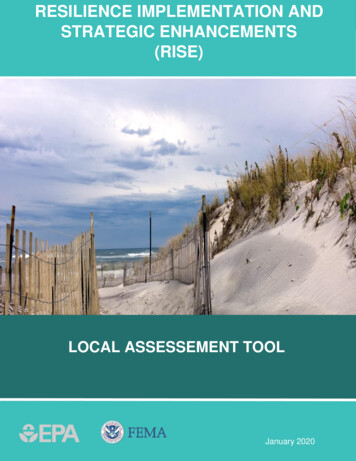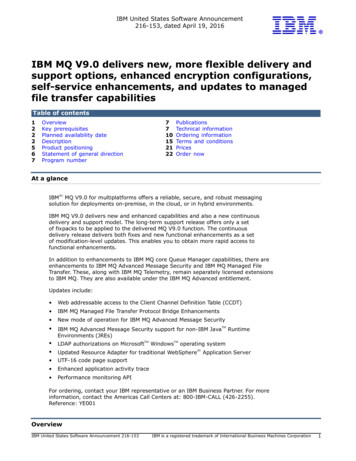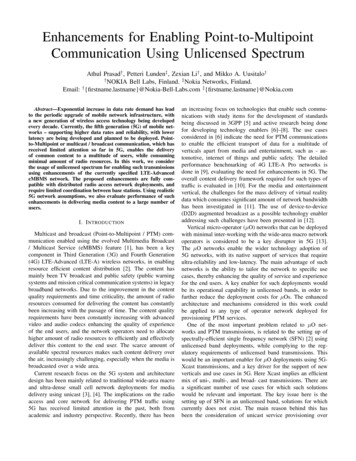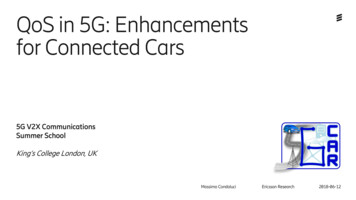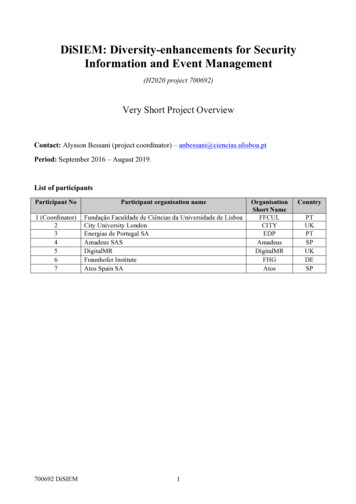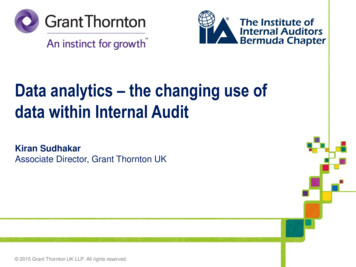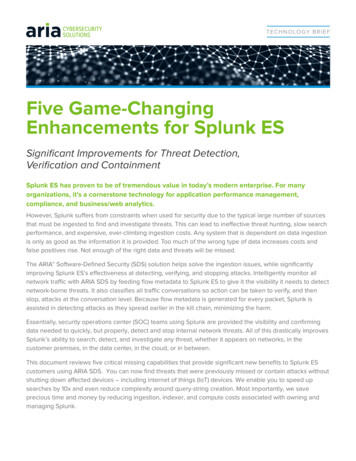
Transcription
TECHNOLOGY BRIEFFive Game-ChangingEnhancements for Splunk ESSignificant Improvements for Threat Detection,Verification and ContainmentSplunk ES has proven to be of tremendous value in today’s modern enterprise. For manyorganizations, it’s a cornerstone technology for application performance management,compliance, and business/web analytics.However, Splunk suffers from constraints when used for security due to the typical large number of sourcesthat must be ingested to find and investigate threats. This can lead to ineffective threat hunting, slow searchperformance, and expensive, ever-climbing ingestion costs. Any system that is dependent on data ingestionis only as good as the information it is provided. Too much of the wrong type of data increases costs andfalse positives rise. Not enough of the right data and threats will be missed.The ARIA Software-Defined Security (SDS) solution helps solve the ingestion issues, while significantlyimproving Splunk ES’s effectiveness at detecting, verifying, and stopping attacks. Intelligently monitor allnetwork traffic with ARIA SDS by feeding flow metadata to Splunk ES to give it the visibility it needs to detectnetwork-borne threats. It also classifies all traffic conversations so action can be taken to verify, and thenstop, attacks at the conversation level. Because flow metadata is generated for every packet, Splunk isassisted in detecting attacks as they spread earlier in the kill chain, minimizing the harm.Essentially, security operations center (SOC) teams using Splunk are provided the visibility and confirmingdata needed to quickly, but properly, detect and stop internal network threats. All of this drastically improvesSplunk’s ability to search, detect, and investigate any threat, whether it appears on networks, in thecustomer premises, in the data center, in the cloud, or in between.This document reviews five critical missing capabilities that provide significant new benefits to Splunk EScustomers using ARIA SDS. You can now find threats that were previously missed or contain attacks withoutshutting down affected devices – including internet of things (IoT) devices. We enable you to speed upsearches by 10x and even reduce complexity around query-string creation. Most importantly, we saveprecious time and money by reducing ingestion, indexer, and compute costs associated with owning andmanaging Splunk.
SIGNIFICANT IMPROVEMENTS FOR THREAT DETECTION, VERIFICATION AND CONTAINMENT.TECHNOLOGY BRIEFHow is this done?1. Create/feed unsampled NetFlow for improved detection and search functionality at loweringestion costThe ARIA SDS solution creates unsampled NetFlow (IPFIX) records for every network packet and feeds itinto Splunk’s free Stream collector. Unlike network switch-generated NetFlow that is sampled at one flowrecord created for every 10,000 packets, ARIA SDS generates NetFlow for every single packet, so thatnothing is missed.Up to 80% of attacks and exfiltrations can be detected within the network data; as such Gartner has deemedthe ability to ingest network data in flow or packet form to be a critical requirement for any device to meet itsclassification of a modern SIEM. Unsampled NetFlow provides the crucial details modern SIEMs like Splunkrequire to detect network-borne threats – in a lightweight form factor that doesn’t overburden ingestion. Thisallows security resources to find malware, ransomware, APTs, and other attacks live as they become activeand not after the fact as detected by log sources – if at all.This approach provides a decrease in ingestion costs by limiting the amount of log sources required to huntthrough to find such attacks. Since NetFlow records are extremely lightweight, with a standard fixed format,ARIA SDS provides quick ingestion with fewer indexers, saving underlying compute requirements. This inturn allows for rapid search results to detect and investigate network-borne threats in seconds as comparedto minutes or longer from typical multi-source, log-reliant threat searches.The NetFlow generated by ARIA SDS is a more reliable source of information. This is because logs can bemanipulated/shut off by a threat actor, or may not provide the level of information an analyst needs to makea proper determination if there is a threat and what it is impacting. A typical practice is to wait for furthercorroborating log inputs that can be found and correlated in Splunk after the threat has fully materialized andthe damage has been done.ARIA SDS allows for the detection of network-borne threats without reliance on logs. SOC analysts can setup the solution to automatically verify threats by redirecting entire live suspect conversations found with theNetFlow information to central detection tools like IPS and DLP. Those devices can both verify and, in manycases, stop the threats in real time. This is yet another way ingestion costs can be reduced by doing thework automatically without the need to ingest large amounts of costly logs from many sources. This is not tosay log sources are no longer needed; however a core set of log sources can now be relied upon to providethe information needed to supplement what the NetFlows can’t find or to complement with added contextthrough correlation.One of the big challenges pertaining specifically to SIEM platforms is the complexity of creating querystrings. Security analysts must write a query string in order to use a SIEM to answer a specific question. Thisquery string defines the question, which means it also defines whether the answer returned includes thedesired data. This is not a trivial task and requires a very special skillset to accomplish.
SIGNIFICANT IMPROVEMENTS FOR THREAT DETECTION, VERIFICATION AND CONTAINMENT.TECHNOLOGY BRIEFIntegration with ARIA SDS is valuable here as it reduces the number of query strings needed when lookingfor data related to network traffic analytics. This is where NetFlow collection by Splunk Stream helps – itidentifies devices and port-level conversations, frequency, duration, and the amount of data passed. It’snot difficult to write a query to see what types of devices are talking, how they attempt to talk, when, andhow much. ARIA goes one step further and provides example queries to find lateral spreads and otherthreat behaviors. In addition, there are plays available which can be run to find such threats. These can beautomated with the ARIA workflow tool or driven directly by a SOAR tool.ARIA Unsampled NetFlow Benefits: Drastically reduces Splunk compute, indexer, and data ingestion costs Detect network-borne threats and attacks that would previously be missed Find threats faster as they are happening live across the network Reduce dependence on log ingestion by using NetFlow Correlate with existing source log data and threat intelligence to enrich alertsand reduce false positives Allow Splunk to see threats impacting IoT or critical production applications that cannot supportan agent or full-blown EDR Remove complexity around threat query string creation2. Capture selective data conversations to provide “definitive” threat confirmationARIA SDS classifies all traffic as it crosses the network. It then can redirect selected traffic data conversationsbased on filters like SRC/DST (live streams) for further inspection as noted above, or it can take a copy of thetraffic to be ingested by Splunk Stream as requested to verify the details of the threat.To reduce the volume of ingested data and save costs, ARIA SDS can redirect these copies to a packetrecorder, which in turn will ingest and index these conversations for quicker searches. It thereby preservesthe actual data and allows detailed searches to be performed on it as required by the SOC analysts. Whencompleted it sends the desired output of these searches into Splunk Stream for a complete record of alldetails related to the threat.This provides Splunk ES with definitive proof by capturing the actual threat data which, improves overallworkflow processes and makes IR more effective. These capabilities allow for more effective incidentresponse (IR) processes, allowing for improved IR work flows that create definitive proof by capturing theactual threat data. This approach speeds up both investigation and follow-on audit work. ARIA SDS can sendcopies of this traffic to other tools such as next-generation firewalls, IDS, UEBA, DLP, etc. for further actionwhen required. In addition, ARIA SDS allows all process actions to be fully automated through use of theARIA Automated WorkFlow (AWF) process tool, or via SOAR tools such as Demisto.
SIGNIFICANT IMPROVEMENTS FOR THREAT DETECTION, VERIFICATION AND CONTAINMENT.TECHNOLOGY BRIEFSelective Packet Capture Benefits: Eliminates the chance of false positives and provides more definitive proof Helps improve the IR process – easily validate and identify the specific threat type Minimizes the ingestion of network data for detailed analysis Helps eliminate the need and cost associated with other IR tools to find this information Aids in assuring compliance with increasingly stringent industry, federal, (FISMA, HIPAA)and all state regulations Reduces the time and cost of audits and third-party investigative analysis3. Stop threats immediately without taking devices or application offlineSplunk’s work typically stops at investigating threats. With ARIA SDS, the real benefit comes from how itautomatically stops the threats from within the network, while doing the least harm.Splunk, with ARIA SDS, can quickly find threats and verify them. ARIA uses its own user interface or APIs tostop the specific threat conversations as they cross the network. This adds critical new effective and efficientways to stop attacks of all kinds. It joins the two other means that are used today. First, being firewalls, whichcan only block external sources from communicating inward. The second being endpoint detection andresponse (EDR) solutions, which can only run on the devices that can support them and for the limited setof threats it understands how to block, on a given machine. Therefore, EDRs create a quandary for manycustomers – they make sense for endpoint devices under the customer’s control, but tend to be CPUintensive and are very difficult to deploy in each VM and container that needs to be dynamically spawnedand provisioned quickly. So, these surfaces tend not to be protected. For example, BYOD, IoT, and legacy OSdevices in medical and industrial environments join this list of devices where EDRs don’t typically work.Since ARIA SDS is already sitting inline, it can be directed to intercept and stop the threat conversations onthe network as they are identified by the SOC team manually or automatically via SOARs leveraging ARIAAPIs. Taking out the threat conversations is a much better approach than taking critical devices or VMsoffline as normal approaches dictate. ARIA allows critical devices to continue to operate until backups canbe safely brought up online.Once threats are found, ARIA SDS can be used to stop such threats permanently by implementing networkbased microsegmentation. By creating device-level connectivity, white or blacklists can ensure devices thatshould not have been communicating at all or not communicating over a certain port or with a particularapplication – never do so in the future.
SIGNIFICANT IMPROVEMENTS FOR THREAT DETECTION, VERIFICATION AND CONTAINMENT.TECHNOLOGY BRIEFInline Threat Conversation Containment Benefits: Keeps critical processes safely running – blocking the threat while providing time for remediationaction plans to be put in place Provides agentless threat containment for environments like IoT, VMs, and containers Provides a surgical means to stop threat conversations anywhere on network – north/south or east/west Improves SecOps’ ability to stop threats quicker without having to wait for devices to be taken offline. Stops threats within minutes of detection (when automated) Provides a simple means to create and enforce network-based microsegmentation connectivity polices4. Automatically detect and stop data breaches while further controlling Splunk ES ingestIntegrating an ARIA Cybersecurity Solutions Packet Recorder with Splunk ES has tremendous upfront value.As new threats are identified, any recorded metadata can be revisited to immediately find all of the impacteddevices. Alternatively, the recorder can be used to capture and then feed only select data into Splunk uponrequest, greatly limiting ingest.The recorder can be driven by plays and automation from the ARIA AWF or SOAR tools. It can also be used tocapture and store anything from NetFlow metadata, to logs, to network traffic, thus allowing control of what goesinto Splunk. Captured data feeds can be replayed such as those recoded against critical assets housing files orPII/PHI – back through applications such as SQL or through tools like Wireshark. This process can identify whichexact records were exposed during a data breach.In fact, the packet recorder can run the ARIA Automated Investigative Response (AIR) application toautomatically search, detect, and auto-extract entire data breach conversations. The ARIA AIR applicationingests threat intelligence alerts sent to it by third-party tools such as firewalls or IDS/IPS tools to trigger itsautomated process. As a result, it alerts of a confirmed data breach along with the complete copy of the dataexfiltrated. This process can be tied into the plays above for SOC teams to follow the containment process tostop these data breaches immediately as they are discovered. In fact, the entire process can be fully automatedto stop the data breach without human intervention.Recording Network Traffic Benefits: Automatic identification of the exact records and devices exposed during a data breach Go back in time to help determine root cause of threats and patient zero Optimize Splunk with triggered, filtered ingestion, yielding better results at lower cost Gain a more effective data breach IR process Detect and stop critical data breaches automatically
SIGNIFICANT IMPROVEMENTS FOR THREAT DETECTION, VERIFICATION AND CONTAINMENT.TECHNOLOGY BRIEF5. Reduce data sets with filtering for improved cost and better resultsRemember in the beginning when it was mentioned that an ingestion-based system is only as good as thedata it brings in? The ARIA SDS data filters also have advanced options to further reduce the data sent forcertain conversation types into Splunk and other detection tools.First, ARIA SDS can classify Splunk’s packet data ingestion by ports, protocols, or applications for everypacket on network – at wire rate. Also, the unnecessary classified traffic is filtered out to reduce the loadand get Splunk the information it needs to do its job faster. Finally, data sets are further narrowed down byshunting streaming applications like Spotify or Netflix that can clog up ingestion and raise costs.The point is less can be more and it’s definitely faster – ARIA SDS gives you all options for the ultimate inflexibility of optimizing your Splunk network ingestion.Filtering Network Traffic Ingestion Benefits: Reduce ingestion costs Reduce false positives Create quicker search results Implement more effective, lower cost IR processesARIA SDS provides a clear advantage to Splunk usersThe issues covered here have definitely been felt by anyone who uses Splunk ES, or any modern SIEM forthat matter. Adding ARIA SDS feeds Splunk better data to find internal network threats and allows Splunkcustomers to reduce the number of log sources that must be ingested. The result: Splunk runs searchesquicker, and with the right data, finds previously missed threats early in the kill chain. The reduced ingestionand the reduction in indexers typically pay for the ARIA platform in a matter of three to six months – drivinga substantial ROI in cost reduction alone over the platform’s lifetime.Contact Us Today: sales@ariacybersecurity.com or 800.325.3110ABOUT ARIA CYBERSECURITY SOLUTIONSARIA Cybersecurity Solutions recognizes that better, stronger, more effective cybersecurity starts with a smarter approach. Oursolutions provide new ways to monitor all internal network traffic, while capturing and feeding the right data to existing security toolsto improve threat detection and surgically disrupt intrusions. Customers in a range of industries rely on our solutions each and everyday to accelerate incident response, automate breach detection, and protect their most critical assets and applications. With aproven track record supporting the Department of Defense and many intelligence agencies in their war on terror, and an awardwinning portfolio of security solutions, ARIA Cybersecurity Solutions is committed to leading the way in cybersecurity success.ARIA Cybersecurity Solutions 175 Cabot St, Suite 210 Lowell, MA O1854Connect with Us: ariacybersecurity.com / Linkedin / Facebook / Twitter / Blogrev2.0-techbrief-10 19-ARIASDS Five Enhancements SplunkES
It also classifies all traffic conversations so action can be taken to verify, and then stop, attacks at the conversation level. . Create/feed unsampled NetFlow for improved detection and search functionality at lower . (live streams) for further inspection as noted above, or it can take a copy of the .

